
Middle Eastern interior design is a gripping fusion of cultural heritage, artistic expression, and architectural brilliance, reflecting the vibrancy and diversity of the regions it encompasses. Spanning across nations like Egypt, Turkey, Iran, and Saudi Arabia, among others, this style is a testament to centuries of history, tradition, and innovation.
Drawing influences from Asia, Africa, and Europe, Middle Eastern interior design showcases a harmonious blend of ornate details, intricate patterns, and opulent textures, adopting the distinctive essence of all these regions. From the grandeur of Persian palaces to the intimacy of Moroccan riads, Middle Eastern interiors exude a sense of warmth and hospitality, welcoming guests into a world of splendour and refinement.
A Brief History of Time (and Middle Eastern Design)
The Middle East boasts a profound historical legacy, shaped by some of humanity’s earliest civilizations. From the pioneering cultures of the Sumerians, Assyrians and Babylonians to the imperialism of the Ottomans and classicism of the Greeks and Romans, a rich fabric of architectural heritage unfolds across the ages. This mosaic of influences, spanning epochs and empires, has bestowed upon Middle Eastern design a rich and multifaceted character.

Among the foremost influences on Middle Eastern interior design stands Islamic art, which blossomed in the 7th century CE. Distinguished by its geometric precision, flowing calligraphy, arabesque motifs, and delicate floral embellishments, Islamic art infuses spaces with elegance. Mosques, as bastions of Islamic architecture, showcase the pinnacle of this aesthetic, with their majestic domes, soaring minarets, and intricately adorned courtyards create a stunning visual effect.

Interestingly, colonialism also left an indelible mark on Middle Eastern design. From the 16th to the 20th centuries, European powers imposed their architectural styles—neoclassical, baroque, rococo, and art deco—on the region, juxtaposing them with indigenous and Islamic aesthetics. This confluence of cultures gave rise to a captivating fusion of East and West, tradition and modernity.
Over time, these diverse influences merged into one another and evolved into a distinct style of architecture and design.
The ABCs of Middle Eastern Interior Design
The design elements of Middle Eastern style comprise distinct features inspired by various cultural and contextual influences: rich textures, vivid patterns, and warm colors. An interesting aspect of this style is its flexibility among all these defining characteristics, allowing for individual expression in every home. Here are a few characteristic features of Middle Eastern Interior Design.
Expressive and Comforting | The Colours

Middle Eastern interiors are usually warm, cosy, inviting, and expressive. The shades of red, orange, yellow, gold, brown, and purple are picked from the natural colour palette of the region— the sun, the sand, and the spices. They are also influenced by Islamic art, which uses rich and saturated colours to create contrast and drama.
‘Like Sunrise, against the Golden Sand’ | The Lighting

Lighting in Middle Eastern interiors is inspired by Islamic art and architecture, featuring geometric patterns, arabesque motifs, floral designs, and intricate details. The style uses forged chandeliers, metal lanterns, and coloured glass lamps, often suspended by chains from the ceiling or placed on the floor. These fixtures create a stunning visual effect through patterned pinpoints of light and shadow around the room, making it feel delightfully intimate.
Soft as velvet, Smooth as Silk | The Textures

The textures utilized in Middle Eastern interior design are typically soft and cozy, including wool, cotton, silk, velvet, and leather. These textures draw inspiration from trade, encompassing items like carpets, rugs, cushions, curtains, and upholstery. Additionally, they are influenced by Islamic art, which employs intricate and detailed textures to fashion patterns and motifs.
Rich and Intricate | The Patterns

Middle Eastern interior design extensively incorporates geometric, floral, or arabesque patterns, which are derived from Islamic art. These patterns are often repeated multiple times, sometimes in symmetrical and complex variations. They are blended with a plethora of colors, creating a sense of diversity and richness in the design.
Fluid, yet Definitive| The Shapes

Curves, arches, or points are defining features of Middle Eastern interior design, often utilized to create frames, borders, and outlines, imparting a sense of structure and stability. The design of windows, doors, niches, ceilings, and furniture imbues the space with a feeling of openness and fluidity.
Harmonious Arrangements | The Composition

In Middle Eastern style, elements are often arranged in a mirror-like fashion, depicting order and unity. Much like Islamic art, these designs curate and compose different elements in harmony with each other, despite being a blend of various principles, styles, and influences. Symmetry, balance, and harmony are also employed to emphasize dominant elements such as fireplaces, windows, or artworks, creating focal points within the space.
Middle Eastern Interior Design of the 21st Century
This distinct style from the Middle East has even adapted to today’s modern and contemporary trends!
Blending Traditional and Western

One of the new trends in Middle Eastern interior design is to blend traditional and Western styles. This is achieved by using a mix of furniture, accessories, and artworks; geometric patterns, sleek lines, warm colours, and metallic accents. It gives the space a familiar, exotic, sophisticated, and stylish vibe.
Minimalist and Sleek Furniture

Minimalist and sleek furniture designs are gradually redefining the characteristics of Middle Eastern interior design. Simple, elegant, and modern, this trend is achieved using furniture with clean and straight lines, smooth and glossy surfaces, and neutral and metallic colours. As a result, the space looks airy and chic, as well as functional and practical.
Adding Personal Touches

The design of Middle Eastern interiors has always been individualistic, expressive, and authentic. Now more than ever, the furniture, accessories, and artworks are defined to reflect the personality, preferences, and culture of the inhabitants. This gives the space a cosy, homely, charming, meaningful, and sentimental look.
Wrapping up

Middle Eastern interior design is a celebration of heritage, craftsmanship, and cultural identity, inviting individuals on a sensory journey through time and tradition. With its richness of colors, patterns, and textures, this style transcends boundaries and captivates the imagination, leaving a lasting impression of beauty and grace.
The style has evolved and adapted over time, heavily influenced by various cultures, geographic contexts, and social developments throughout history. And yet, it clearly has the scope to adapt to changing fashion trends and aesthetics, allowing it to be timeless.
Adopting a modern approach to Middle Eastern styles can help in creating a unique and eclectic look while respecting the cultural and religious aspects, finding the right balance, and avoiding stereotypes and clichés. Middle Eastern interior design is a style that can enhance the mood and atmosphere of any space, by creating a sense of warmth, cosiness, elegance, and beauty. At the same time, it is a style that can also reflect the history, heritage, and identity of the region, as well as the creativity, innovation, and style of the inhabitants.
References:
- https://www.oppeinhome.com/middle-east-decoration-style-decoration
- https://www.contractors.com/guide-middle-eastern-inspired-interior-design/
- https://www.lovehappensmag.com/blog/2022/07/01/middle-eastern-motifs-in-interior-design/
- https://www.lushome.com/middle-eastern-interior-design-trends-home-decorating-ideas/121256
